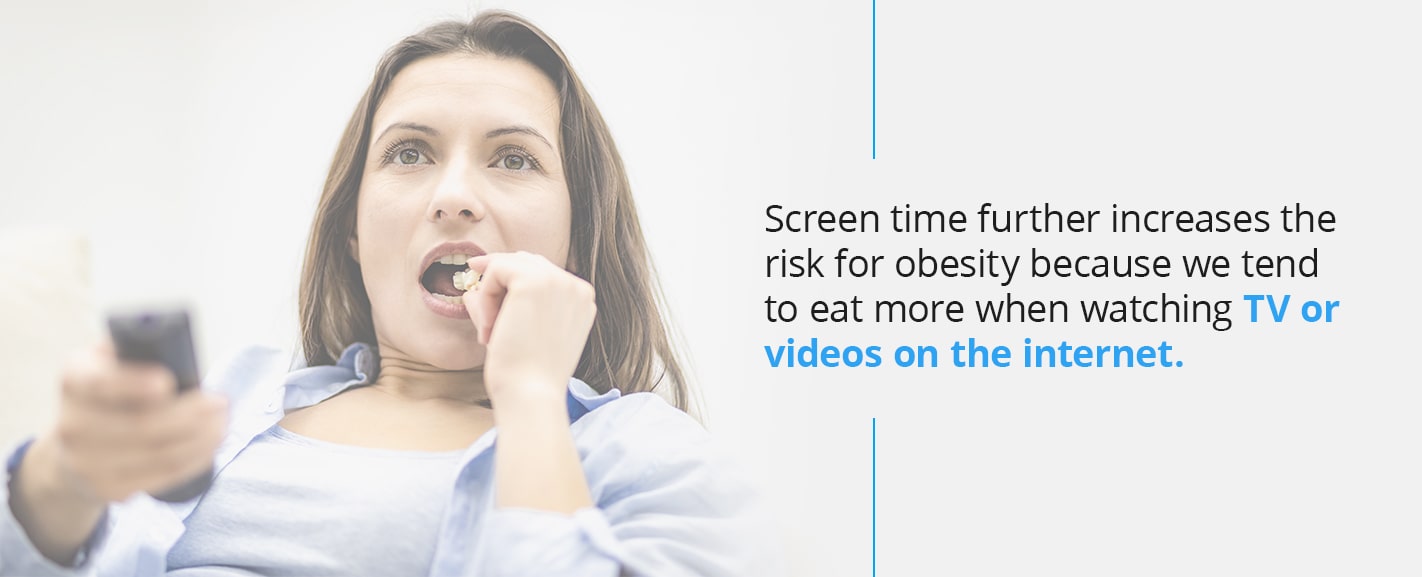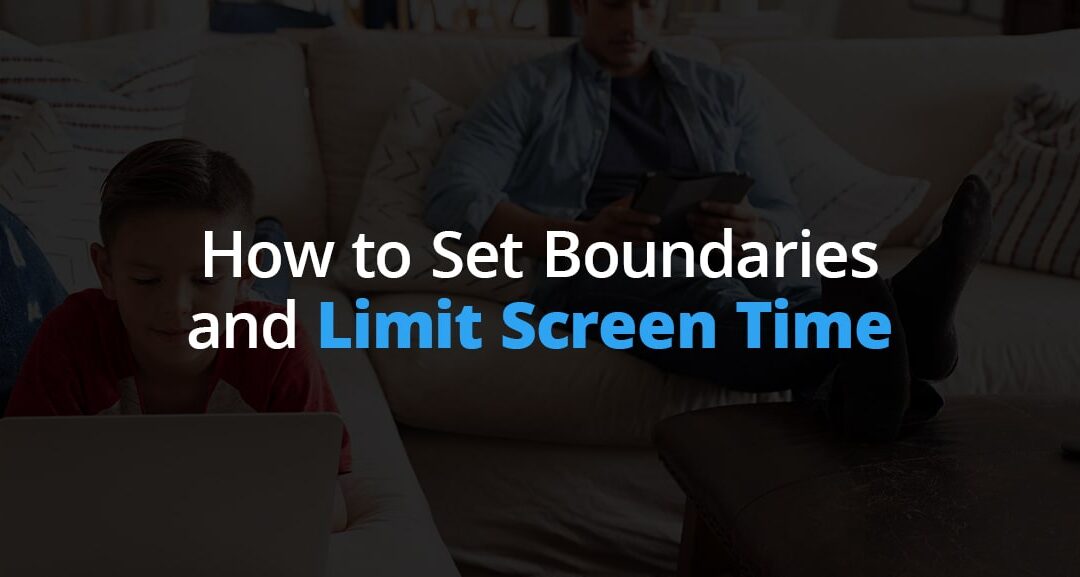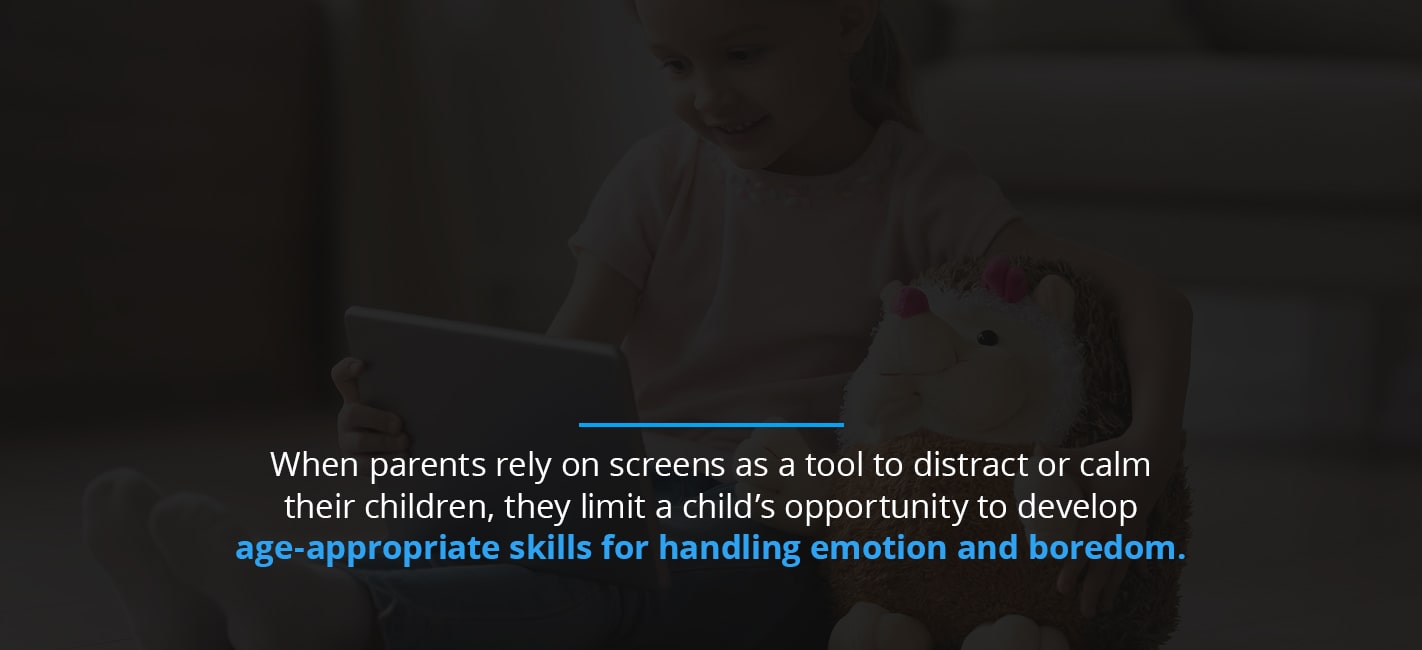Digital screens are a part of everyone’s life. As more school and work environments allow for long-distance and at-home options, daily media use has become increasingly necessary to our society. According to the American Academy of Pediatrics (AAP), children aged 8-12 spend an average of 4 1/2 hours a day on screens. Another 2019 report found that teens and young adults spend an average of 7 1/2 hours or more on screens. These numbers exclude the time spent on digital devices related to work and school. In the past, health experts have suggested reducing screen time to two hours per day outside of work or school-related activities. AAP now recommends we consider other differences in types of screen time. Rather than a general time limit, some health experts advocate for distinctions in digital usage when it comes to setting boundaries and limits. Appropriate use of screen time can keep us connected and enhance learning. Whether you want to encourage positive behaviors in children, teens or yourself, you must allow for active pursuits of screen time. Digital screens will continue to have a place in society, so teach and learn healthy habits by reducing the time spent on passive screen use. With all this in mind, how do we set boundaries for screen time that encourage appropriate screen use with limitations?
Why Is It Important to Set Screen Time Boundaries?
In our modern world, it is essential to set screen time boundaries for people of any age. Even the slightest reductions in screen use can positively affect your health and your children’s development.

Effects of Screen Time on Health
According to the Mayo Clinic, in 2019, an abundance of poor quality screen time during early years of growth has been linked to the following health and behavioral concerns later in life:
- Poor social skills
- Health afflictions, such as obesity, diabetes, increased blood pressure or cholesterol
- Irregular sleep patterns and trouble sleeping
- Behavioral problems
Screen time is generally a sedentary activity, meaning individuals are using very little energy. Screen time further increases the risk for obesity because we tend to eat more when watching TV or videos on the internet. Ads show unhealthy food choices and influence us to consume more salt, sugar and fats in our diet. Too much screen time can make it more difficult to sleep at night. The blue light emitted by electronic devices can affect the brain’s sleep cycle. Additionally, the activity that our brains experience when watching a TV show can continue to fire at an intense rate even after we turn off the screen. When you forgo the guideline of one hour of screen-free time before bed, you can experience trouble falling asleep or irregular sleep patterns throughout the night. Further studies have reported links between the overuse of screens and:
- Poor posture, causing chronic neck, shoulder and back pain.
- An increase in loneliness and depression, specifically in teens.
- Severe impacts on relationships.
- An increased risk for attention problems, anxiety and depression.
The National Alliance on Mental Illness (NAMI) found that too much screen time can increase mental health risks, including social isolation, cyberbullying and decreased life satisfaction. Forming healthy habits at a young age is an excellent start, but it is vital to remember that people can make changes at any point to limit screen time and improve health.
Give Us a Call at (978) 482–7351
Benefits of Limiting Screen Time for Kids and Adults
Both kids and adults have demonstrated several benefits from screen time limits and boundaries, including:
- More time spent together with family.
- An increase in face-to-face interactions and improved social behaviors.
- More time spent outdoors and exercising.
- Improved physical health, sleep patterns and lower body mass index (BMI).
- Improved academic performance.
- Reduced exposure to media violence.
- Reduced aggression and better emotional awareness.
Set screen time limits by age and fully consider each child’s needs. Be ready to make new rules or modify old ones based on changes in technology, too. Everyone is different, and some screen time can have positive effects — balance and moderation are the keys to setting successful boundaries.
Limiting Screen Time for Elementary Age Children
Limiting screen time for kids can be tricky, so it’s essential to remember the long-term benefits of setting child device limits. When parents rely on screens as a tool to distract or calm their children, they limit a child’s opportunity to develop age-appropriate skills for handling emotion and boredom. Children must build self-regulatory skills as they grow, and screens can interfere with this process if their use is left unrestricted.
Tips to Reduce Screen Time for Kids
As a general guideline, AAP recommends that children older than 6 years have no specific time limit. Instead, place consistent limits on the time spent using particular types of media. Ensure that adequate sleep, physical activity and other behaviors essential to health are unaffected by screen time with the following tips:
- Encourage children to practice valuable independent and social skills: Rather than cultivating a reliance on media use to calm down or curb boredom, teach children to communicate and understand their emotions. Let them settle down on their own and provide creative outlets for them to pursue.
- Talk to them about the effects that too much screen time can have on their health: Provide things kids can do to be healthier. Communication is the best first step towards implementing limits for screen use.
- Provide alternatives, especially ones that involve physical activity: Suggest new ways to occupy their time. Family board games, puzzles and going on walks are great ways to connect with your kid and keep them off their screens.
- Designate screen-free times at home: Set specific periods when everyone in the family shuts off their digital devices — times where your kids and you are fully present in a task and with one another. During meals and before bed are excellent choices for family time without screens.
- Create a charging station in a common area of the house: Portable devices can make keeping track of your children’s screen activity more tricky. Enforce cellphone and iPad screen time limits with a screen station, and check that everyone’s mobile devices gets plugged in for the night in one place.
- Know what your child is viewing: Watch content with your child to appropriately discuss the themes present. When you engage in your child’s interests, they will be more likely to approach you with questions and open communication further down the line.
- Understand the parental controls and screen time settings you can utilize: While these controls may not catch everything, they can help provide peace of mind and protection. Look into settings on their devices that can limit the screen time spent in specific apps per day.
- Decide on TV shows or movies to watch ahead of time: This plan provides structure and ensures you know the exact amount of time your children spend in front of the screen. Turn off the TV when those programs are over and avoid leaving the TV on for background noise as this can be a distraction.
Limiting Screen Time for Middle Schoolers
Many of the tips for elementary-age children can still apply to middle schoolers. The key is to adapt these screen limits into healthy habits for your children as they grow more independent.
How to Adjust Your Boundaries for Middle Schoolers
The following tips can help you reduce your middle schoolers’ passive screen time:
- Avoid multitasking: When trying to do two things at once, our brains cannot fully concentrate on either task. Show your kids that total concentration on their schoolwork can help them finish it faster.
- Keep bedrooms screen-free: As children grow, they may request TVs and other electronic devices for their bedroom. TVs in the bedroom encourage children to spend less time in family spaces. On average, kids with TVs in their bedroom spend an additional 1 1/2 hours of screen time per day than those without one.
- Educate children on “fear of missing out” (FOMO): Digital devices and social media make it easy to see what others are doing at all times. It is vital to stay in touch with friends, but solely interacting online can be isolating. Provide alternatives for your children to do in real life and share the experience of being in the moment.
- Continue to build self-regulation skills: Work on age-appropriate cognitive, emotional and physiological responses so your child can handle unexpected situations better — whether they’re at home, at school or in other social interactions.
As your children grow older, it is crucial to offer them control over how and when they use a screen. Give them the chance to turn the screen off. Warn kids before their screen time’s up, so they better understand how much time was spent on their screen and adapt their behaviors over time. Avoid turning a TV show off before it’s finished or unplugging a game at mid-level, as these actions can create resentment towards your boundaries. Allow your child a little agency and let it become a welcomed habit instead.
Limiting Screen Time for Teenagers
Teenagers use screen time in various helpful ways, from finding support online to comfortably exploring sensitive topics like sexuality. Today, screens have helped many students avoid social isolation and participate in events that may have otherwise been canceled. Though the internet can contain inappropriate material, it is essential to set boundaries that allow these helpful and active pursuits to continue while protecting your child from the harmful realities of digital spaces.
Screen Time Boundaries for Teenagers
As with middle schoolers, you should allow your child more freedom and control over their screen time as they grow older. When you make rules without any discussion, they can feel like a punishment instead of a benefit:
- Discuss rules before implementing them: Listen to suggestions that your teenager may have and develop plans that work for both of you.
- Provide a variety of free time activities: Boredom and the desire to socialize are the top two reasons teens say they go online. Make sure teens can spend time with friends and encourage them to play sports or get active.
- Know what your teen is doing with their screen time: Your child’s interests will change over time, so remain engaged in what your teenager enjoys — preview the video games they play, watch episodes of their favorite TV shows and ask them to play their music in the car. If you have a concern with the themes, start a healthy discussion about it.
- Teach your teen about internet safety: Inform them about the dangers of sharing private information online and the importance of privacy.
- Be a role model: Children of all ages — especially teens — notice your behaviors and assume they’re acceptable. Demonstrate appropriate screen usage and follow the same time limits that you expect of them.
Limiting Screen Time as an Adult
Most adults uphold that we should limit children’s screen time to the recommended two hours per day, even though few adults adhere to this screen time limit for themselves. Nearly 40% of children say their parents use their digital devices too frequently, and in a 2018 national survey, one-third of teen respondents said their parents should spend less time on social media.
How to Limit Screen Time as an Adult
Follow these tips to limit your screen time, improve your health and set an excellent example:
- Be aware of the impact you make in the lives of those around you: Children of all ages will be more willing to accept boundaries if they see you do the same. Screen time limits are beneficial to everyone, so there are plenty of reasons to lead by example.
- Track your screen time: Many people underestimate the amount of time they spend on screens each day. Keep records and visualize your screen habits. Make changes for the future that balance your screen time with time being physically active.
- Take breaks from work away from your computer and mobile devices: Too much screen time can cause back and neck pain, so you should stand or stretch often. Many adults experience burnout from jobs that pressure them to remain connected on digital devices outside of work hours. Know the risks of too much screen time and address concerns when they arise.
- Switch off unnecessary notifications: Most notifications from social media apps will not need your immediate attention. Turn off these distractions so you can focus without regular interruptions throughout the day.
Seek Professional Guidance With Merrimack Valley Psychological Associates
Screen addiction is real and can have long-term effects on your health and well-being. Professional guidance can help you work through the conditions caused by too much screen use and support you throughout your journey. Signs that you should seek professional guidance for yourself or someone you care for include:
- If screen time regularly disrupts normal activities or family events.
- If things someone used to enjoy no longer bring enjoyment.
- Problematic mood changes, lack of motivation or conflicts over screen limits.
The counseling services at Merrimack Valley Psychological Associates can help if you notice any of the above concerns. We offer treatment options that work for various conditions related to the overuse of digital devices and screens. Schedule an appointment with one of our clinicians for a clinically tested and approved treatment that is optimal for you or your loved one.
Reviewed By
Dr. David Rainen, PsyD.
I am a licensed clinical psychologist with an extensive background treating a variety of different ages, situations, emotional and mental health disorders in individuals and their families. As part of my 10 year professional and training career in psychology, I have developed and refined my skills and approaches through my work in a variety of diverse settings including: hospitals, community outpatient facilities, college counseling centers, secure and unsecure inpatient/residential treatment programs, and therapeutic day schools.




